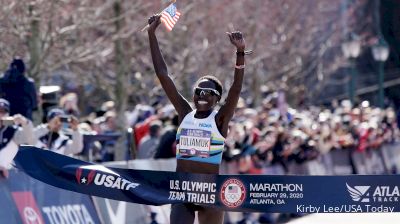Biggest Olympic Trials What-Ifs
Biggest Olympic Trials What-Ifs
Look at some of the biggest what-ifs from Saturday's race.

Unlock this article, live events, and more with a subscription!
Already a subscriber? Log In
In a race filled with unbelievable results, here are a few of the biggest what-ifs from the U.S. Olympic Marathon Trials in Atlanta.
What if Jake Riley missed the Olympic team while holding a flag?
In my junior year of high school, I was tripped midway through a 3200m race at the regional meet. Rather than gradually work my way up to the pack, I did the following:
1) Saw the state meet slipping away
2) Panicked
3) Sped off to catch the lead pack.
I joined the group about a lap later, but the damage had been done. The big surge in the middle race took its toll on my legs. My quads disintegrated in the last 400m and I collapsed five meters from the finish line. I got up, crossed the finish line, only to collapse again. The lasting legacy of that race (other than qualifying for the state meet where I stayed on my feet, but I was so far back I looked like I was tripped) was that I was known as “the guy who fell” for my senior year. It felt cool to be remembered for something, but that wasn’t exactly what I wrote on the goal board at the beginning of the season.
On Saturday, Jake Riley almost earned a much more permanent title as “the guy who lost while carrying a flag.”
As Lincoln outlined yesterday, someone handed him a flag with the race very much still in doubt. With Leonard Korir and Abdi Abdirahman looming, the flag sat in Riley's had more like a baton and less a celebratory symbol.
If he did get outkicked, his destiny would have been written. It would have been the story from the Trials in mainstream sports news—meme'd, GIF'd and forever known as the guy who grabbed the flag and lost.
What if Molly Seidel ran in Alphaflys?
This didn’t occur to me until the day after the race, but I think it’s fair to say that Seidel’s Sauconys saved us from a collective freak out. Let’s take into account the following facts, as they would have been presented to the public:
-Seidel had never run a marathon before Saturday
-Her half-marathon personal best of 1:09:35 is good, but not extraordinary for the assembled field
-She considered a good day for her to finish in the top 20
If she was wearing the Alphaflys, all of the context about being a high school national champ, then a college champion, and then missing time with an eating disorder and frequent injuries would have been washed away.
Instead, her story would have been another proof point in the argument against Nike's super shoes. How did a woman who never ran a marathon beat the deepest field in U.S. history? It must be the green and black boats on her feet.
Instead, she ran in Sauconys so we didn’t really talk about it.
What if Des Linden didn’t plan on running in Boston?
Linden told Nick Zaccardi of NBC after the race that she briefly thought of dropping out when she lost contact with the lead group.
Because she’s Des Linden though, she didn’t. In fact, she almost ran herself back into an Olympic spot.
But it had to be tempting to call it a day and prepare for April’s Boston Marathon.
In the psychological torture chamber that is the marathon, having a back-up plan isn’t always helpful. Jake Riley’s philosophy of “no more next times,” provided a finality to the race that propelled him in the final miles.
Linden is a pro, she’d started 19 marathons before Saturday and finished 18 of them. Even though the leaders gapped her and the wind and hills were unrelenting, she defaulted to her normal pre-sets. Boston or not, she was going for the top three.
“Pull your head out of your ass and go,” she told Zaccardi.
What if the Trials course mimicked the Olympic course?
This was the plan, but when the Olympic marathon was moved from Tokyo to Sapporo due to concerns about the heat, the hills of Atlanta were less relevant. It was too late to switch the course for the Olympic Trials, so the result was a course that wasn’t modeled after what runners would encounter at the Olympics.
The women’s top three was so unlikely that it’s not a stretch to say the results would have been vastly different on a flat course. Even if you ran that race on the same course again, you’d probably get a new top three just because of how deep the women’s field was this year. Molly Huddle, Emily Sisson and Sara Hall didn’t finish and all remarked at the toll the course took on their bodies. Sisson was so good in her London debut that she would have benefited greatly from something with fewer climbs.
On the men’s side, Rupp was prepared to win on any type of course. Past that, who knows.
Did pre-race favorites Leonard Korir, Scott Fauble and Jared Ward struggle because of the hills? Or, was it just not their day? Abdi Abdirahman’s ability to show up and perform virtually every time there’s an Olympic team on the line is staggering. The challenge of the course probably helped experienced runners like himself, but he certainly could have adapted to anything thrown his way.